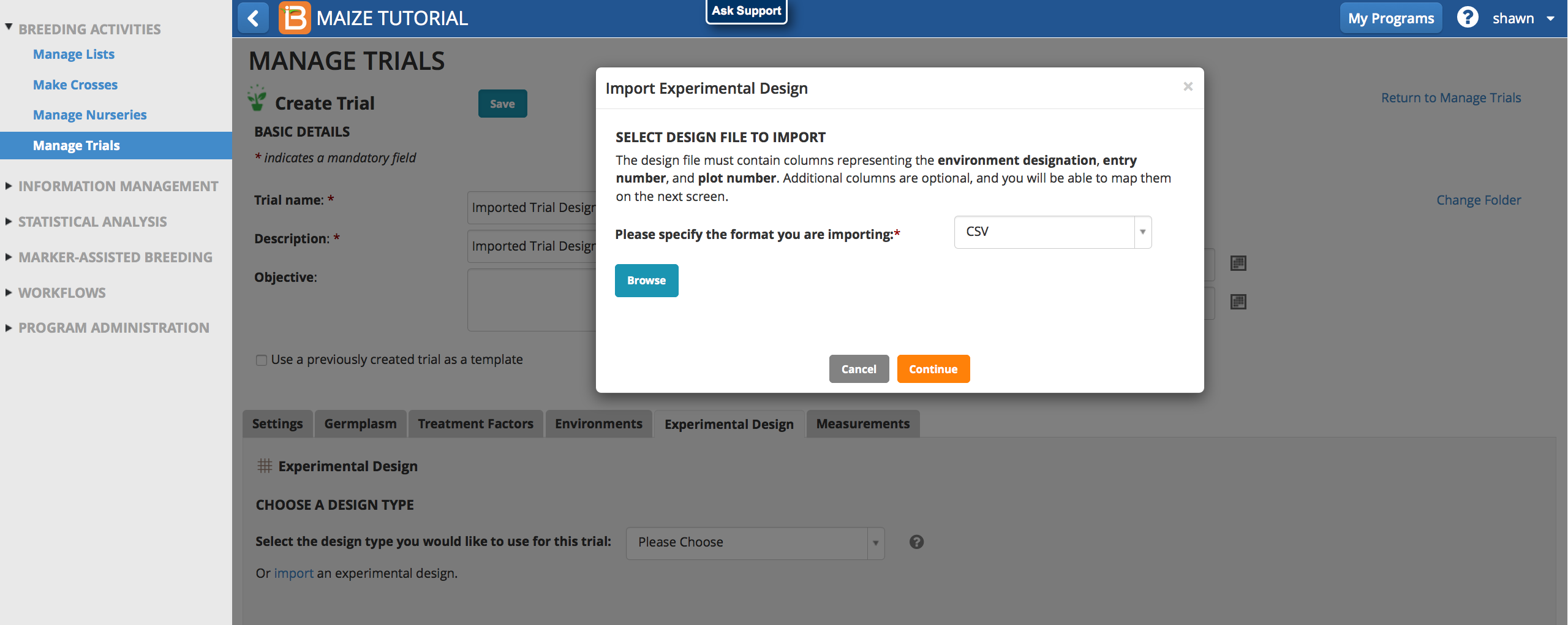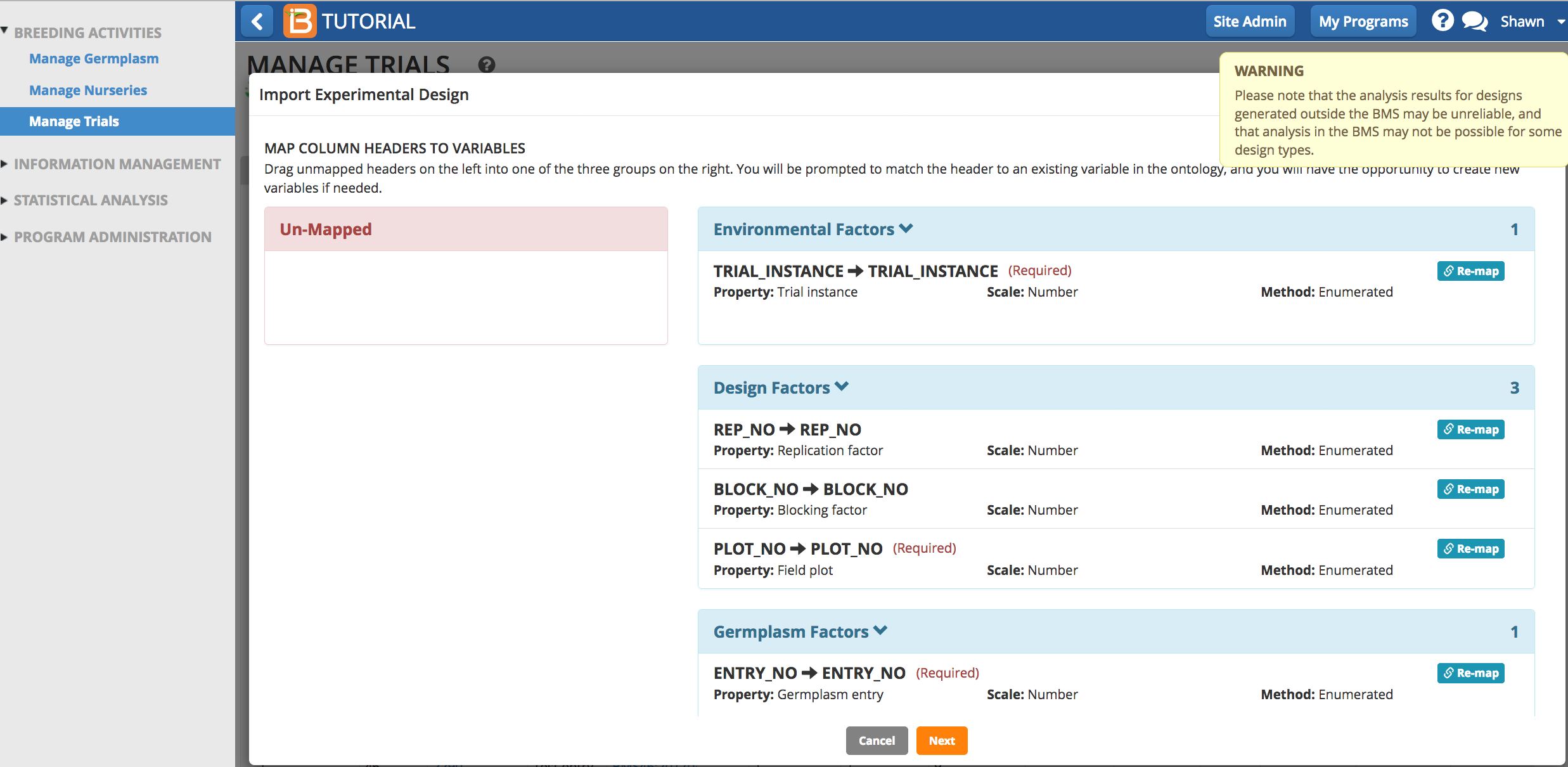About Design
The BMS will generate several different study designs. The first four are randomized by the BMS and compatible with statistical analysis. The last type, entry list order, is not randomized by the BMS - plots are allocated based on entry list order. The BMS will accept any design via import of design .csv file (see more below).
- Randomized Complete Block
- Resolvable Incomplete Block
- Row-and-Column
- Augmented Randomized Block
- Entry list order
Randomized Designs
Randomized designs are created via ASreml design engine, a proprietary element of the BMS. When you run a design, the system checks the license via internet. If you experience an error message about a missing license, please contact your system administrator. Checks can be included in randomized designs (see more about checks under Study Germplasm)
Randomized Complete Block Design
The simplest blocked design is the Randomized Complete Block (RCB) design. In this design each of the v, treatments occurs once in every block (or replicate), and the number of units per block, k, is constant and equal to the number of treatments (v = k). These characteristics result in a balanced dataset, and therefore, any treatment comparison has the same precision. Treatment factors can be added to RCB designs (see more Treatment Factors).
- Select Randomized Complete Block design as the experimental design. Enter the number of desired replications and select Generate Design.
After receiving a success message, the Measurements table is now populated with a randomized complete block design.
Resolvable Incomplete Block Design
In a resolvable Incomplete block design plots are grouped into blocks that are not large enough to contain all germplasm (treatments), and resolvable blocks are created by grouping incomplete blocks together, so that each treatment is replicated exactly once in each group or set.
- Select Resolvable Incomplete Block Design as the experimental design. Enter the number of desired replications. Enter the number of blocks - number of blocks must be a factor of the number of treatments. Select Generate Design.
After receiving a success message, the Measurements table is now populated with a resolvable complete block design.
Row-And-Column Design
When the heterogeneity is known or suspected in two directions (rows and columns), Row-and-Column (RC) designs can be used to group experimental units in two directions. The purpose of a RC design is to eliminate equally from the errors all differences among rows and among columns. Under these situations, the experimental material should be arranged and the experiment conducted so that the differences among rows and columns represent major sources of variation.
- Select Row-And-Column Design as the experimental design. Enter the number of desired replications. Enter the number of row and columns within the replications. The number of rows multiplied by the number of columns must equal the number of treatments - in other words, the number of treatments must divisible by the number of columns. Generate Design.
After receiving a success message, the Measurements table is now populated with a Row-and-Column design.
Augmented Randomized Block Design
Augmented Randomized Block Design is constructed using control or "check" entires for which there are sufficient seed to allow several replications (see more about checks under Study Germplasm). The number of available experimental plots in each replication may vary, but all of the checks are included at least once; the remaining plots are assigned to the new or "test" entries. Performance of the checks can be used to adjust the performance of the test entries to make them comparable across replications and to provide an estimate of experimental error so that valid statistical tests can be performed.
- Specify Augmented Randomized Block Design and enter the number of desired blocks. The number of experimental blocks must be a factor of the number of test entries. In this example, there are 2 check entries and 245 test entries. Factors of 245 (1,5,7,35,49) are options for block number in the experimental design. Generate design.
After receiving a success message, the Measurements table is now populated with an augmented randomized block design.
Entry List Order (Non-Randomized)
In this design type the system will just take the entry list and assign one plot for each entry in the order established in the list by default.
- Specify "Entry List Order". If your germplasm list has checks (see more about checks under Study Germplasm), you will be asked to specify.
- Starting position: where the first check will be inserted (default is plot #1).
- Spacing: the number of test entries between check insertion points
- Manner of insertion:
- Insert each check in turn: will add one check, per insertion point.
- Insert all checks at each position: will add the complete list of checks at a given insertion point
After receiving a success message, the Measurements table is now populated with your test and check entries.
Import Custom Design
This feature allows you to import custom trial design files (.csv) generated outside of the BMS. Randomizations created outside of the BMS may not be supported by BMS statistical analyzes, but users have the flexibility to use external statistics applications if desired.
Template
- Export Design Template.
The exported design template (.csv) contains the 3 mandatory column headings
- TRIAL_INSTANCE: Number corresponding to specific trial environments, like a particular location or season.
- ENTRY_NO: Number corresponding to specific germplasm. The number of entries in the trial design file must equal the number of entries in the trial germplasm list.
- PLOT_NO: Plot number

- Edit the design template. Some experimental designs will require the addition of other optional columns.

- Select Import an Experimental Design.
- Specify the design file and Continue.

Ontology Mapping
Terms that are identical to the ontology will map perfectly. If the column headers are spelled differently, the system will attempt to map to match the existing ontology. You may be required to Re-map and/or add new ontology terms to achieve correct mapping.

- Review imported design details and select Finish.


